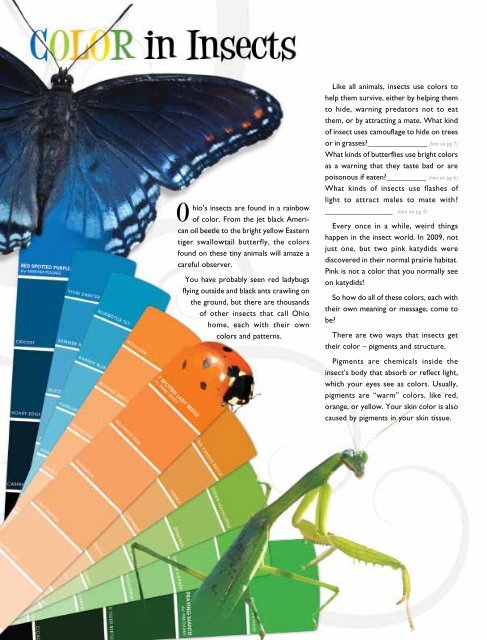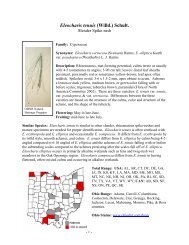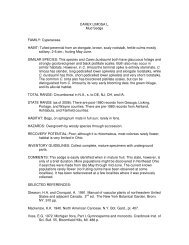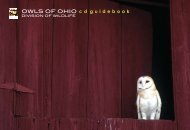hio’s <strong>in</strong>sects are found <strong>in</strong> a ra<strong>in</strong>bow<strong>of</strong> color. From the jet black Americanoil beetle to the bright yellow Easterntiger swallowtail butterfly, the colorsfound on these t<strong>in</strong>y animals will amaze acareful observer.You have probably seen red ladybugsfly<strong>in</strong>g outside and black ants crawl<strong>in</strong>g onthe ground, but there are thousands<strong>of</strong> other <strong>in</strong>sects that call <strong>Ohio</strong>home, each with their owncolors and patterns.Like all animals, <strong>in</strong>sects use colors tohelp them survive, either by help<strong>in</strong>g themto hide, warn<strong>in</strong>g predators not to eatthem, or by attract<strong>in</strong>g a mate. What k<strong>in</strong>d<strong>of</strong> <strong>in</strong>sect uses camouflage to hide on treesor <strong>in</strong> grasses?_______________ (h<strong>in</strong>t on pg 7)What k<strong>in</strong>ds <strong>of</strong> butterflies use bright colorsas a warn<strong>in</strong>g that they taste bad or arepoisonous if eaten?__________ (h<strong>in</strong>t on pg 6)What k<strong>in</strong>ds <strong>of</strong> <strong>in</strong>sects use flashes <strong>of</strong>light to attract males to mate with?_________________ (h<strong>in</strong>t on pg 9)Every once <strong>in</strong> a while, weird th<strong>in</strong>gshappen <strong>in</strong> the <strong>in</strong>sect world. In 2009, notjust one, but two p<strong>in</strong>k katydids werediscovered <strong>in</strong> their normal prairie habitat.P<strong>in</strong>k is not a color that you normally seeon katydids!So how do all <strong>of</strong> these colors, each withtheir own mean<strong>in</strong>g or message, come tobe?There are two ways that <strong>in</strong>sects gettheir color – pigments and structure.Pigments are chemicals <strong>in</strong>side the<strong>in</strong>sect’s body that absorb or reflect light,which your eyes see as colors. Usually,pigments are “warm” colors, like red,orange, or yellow. Your sk<strong>in</strong> color is alsocaused by pigments <strong>in</strong> your sk<strong>in</strong> tissue.
COLOR SCHEME: SPLIT COMPLEMENTARYSplit complementary color comb<strong>in</strong>ations consist <strong>of</strong> a foundation hue and two colors equally spaced oneach side <strong>of</strong> its opposite color on the color wheel. This color scheme has the same strong visual contrastas the complementary color scheme.Other colors are created by lightreflect<strong>in</strong>g <strong>of</strong>f <strong>of</strong> the structure, or shape,<strong>of</strong> the <strong>in</strong>sect’s body. Over the s<strong>of</strong>t tissue<strong>in</strong> the body <strong>of</strong> an <strong>in</strong>sect are two layers<strong>of</strong> material, together they are called thecuticle. One layer is waxy and waterresistantand the other is hard and made<strong>of</strong> chit<strong>in</strong>, a substance also found <strong>in</strong> crustaceanshells.ACTIVITY: OBSERVATION CHARTGrab a notebook and spend five m<strong>in</strong>utes <strong>in</strong> your favorite outdoor area look<strong>in</strong>g carefullyfor <strong>in</strong>sects. Search on trees, flowers, grass, and even sw<strong>in</strong>g sets for these t<strong>in</strong>yanimals. Keep track <strong>of</strong> how many <strong>in</strong>sects you see and what colors they are. You do notneed to know the names <strong>of</strong> all the <strong>in</strong>sects, just write down your observations <strong>of</strong> theircolor, shape, and size.Create a bar graph by fill<strong>in</strong>g <strong>in</strong> a square for each <strong>in</strong>sect <strong>of</strong> that color you see.(example: you saw (3) red bugs, so you fill <strong>in</strong> ( ) boxes)When light passes through the <strong>in</strong>sect’scuticle, it bounces <strong>of</strong>f the layers <strong>of</strong> materials,like light bounces through a prism. Thebounc<strong>in</strong>g light appears to you as differentcolors. Usually, this bounc<strong>in</strong>g light gives<strong>in</strong>sects “cool” colors like purple, blue, andgreen.1098765Sometimes, depend<strong>in</strong>g on the way youlook at an <strong>in</strong>sect, it may look like it ischang<strong>in</strong>g colors. This is called iridescence.You can see great examples <strong>of</strong> iridescenceon dragonfly w<strong>in</strong>gs and tiger beetles.Other <strong>in</strong>sects, like the metallic woodbor<strong>in</strong>gbeetle, have a metallic sh<strong>in</strong>e totheir bodies. Both iridescence and metalliccolors are created by the structure <strong>of</strong>an <strong>in</strong>sect’s body.4321BLACKBROWNREDORANGEYELLOWGREENBLUEINDIGOVIOLETWHITEClose observation can help you seea whole new ra<strong>in</strong>bow <strong>of</strong> color outside.Your challenge is to f<strong>in</strong>d as many differentcolored <strong>in</strong>sects as possible. The graph onthe this page will help you track whichcolors you see most <strong>of</strong>ten.BLUEBOTTLE FLYby DANNY BROOKSTRUE KATYDIDby JIM M C CORMACIS A SPIDER AN INSECT?While they may seem like the samecrawl<strong>in</strong>g creatures, there are def<strong>in</strong>ite differencesbetween spiders and <strong>in</strong>sects.Here are a few: Spiders have a total <strong>of</strong> eight legs (comparedto an <strong>in</strong>sect’s six legs). A spider’s body is two parts, cephalothoraxand abdomen, unlike the three--part head-thorax-abdomen <strong>of</strong> an <strong>in</strong>sect. Most <strong>in</strong>sects have w<strong>in</strong>gs - spiders don’t.BOXELDERby LISA BROWNWhat colors did you f<strong>in</strong>d most <strong>of</strong>ten? ___________________________Why do you th<strong>in</strong>k you found those colors more than the other colors?2011 - 2012 WILD OHIO MAGAZINEPLUME MOTHby DANNY CHAPMAN17

















